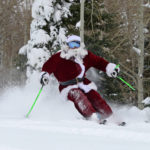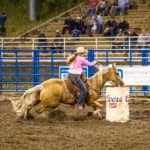Sharing the Mountain with Wildlife

Skiers and snowboarders aren’t the only beings frequenting the slopes of Steamboat Resort. Sharing the land with the native animals that share these beautiful mountains is high priority for Steamboat Resort. Wildlife mitigation is part of our operations plans with a focus primarily on three different native animals: moose, elk and Canada Jays.
Most notably, the Shiras moose, which is Colorado’s largest big-game animal, is commonly seen on and around the slopes of Steamboat Resort. Weighing up to 1,000 pounds and towering more than six feet at the shoulder, these moose are a majestic sight when seen from a safe and appropriate distance. As Sarah Jones, Steamboat Resort’s Director of Social Responsibility explains, “Moose don’t shoo,” and can be quite dangerous to anyone who encroaches on their territory. While moose may appear to be friendly and harmless, they can actually be extremely aggressive and unpredictable. Giving these wild animals plenty of distance and respecting their space is key in a balanced coexistence.
Certain areas of the mountain are home to moose during the winter months, in particular areas near BC Ski Way, Why Not, Vagabond and Bashor. The packed slopes make travel much easier for moose when the snow really starts to pile up. If a moose is seen on or near a resort trail, Ski Patrol is the first to respond by closing the run, if needed, to maintain a safe distance for everyone, including the moose. While education is key to promote safety around these beautifully majestic mammals, so too is the work that Colorado Parks and Wildlife (CPW) is doing to track these moose and learn more about their habitats and movement patterns.
From 2017 to 2021, CPW tracked a group of 21 collared moose, and another group of 10 moose were recently collared in October 2022 to begin an additional four-year study. These tracking collars have a 4-year battery life and automatically release at the end of that period. It is estimated that 30 moose live within Steamboat Resort boundaries during the spring and fall, and up to 10 live in-bounds during the winter, according to CPW Biologist Eric VanNatta. With Steamboat Resort’s ongoing expansion and development, CPW is identifying how the native moose are responding. Next season 650 acres of new terrain will be added to Steamboat Resort in the Mahogany Ridge and Fish Creek Canyon areas that are home to moose. In order to mitigate potential encounters and conflict, VanNatta explains that education and Ski Patrol management will be key.
Another large and native wild animal that Steamboat Resort is taking strides to protect is the elk. South of Valley View and Broadway, where the ski area boundaries end, is where a large herd of elk spend the winter, and protecting their native habitat is extremely important. Signage, closures at the boundary lines and education are the main ways Steamboat Resort is communicating this to guests, and respecting their habitat ultimately is our social responsibility. The United States Forest Service can give tickets to people who trespass into the closed terrain, and for now, Steamboat Resort can issue warnings (although that may shift in the future to a harsher penalty). During the winter months, survival of wildlife is often a struggle, and if we can do our part to minimize any stress imposed on these native creatures, we’re helping to give them their best chance of survival. As Jones explains, “we need to ask ourselves how we can be the best guests and stewards of our mountain wildlife.”
A different type of animal, the Canada Jay, is also forefront in Steamboat Resort’s wildlife mitigation plan. Also known informally as “Gray Jays” and “Camp Robbers”, the primary focus with these wild birds is educating people not to feed them. Canada Jays store food and are masters at surviving in this often harsh winter climate, and the quality of human food is simply not good for them. You have likely seen signs on Morningside chairlift about not feeding the birds and letting nature be, and as Jones says, “we don’t want to disturb nature, we want them to be as healthy as they can be.” It took about a year to break the bird-feeding habit, which was better than expected, but education and communication around the issue is still important to current and future guests.
A favorite quote from Jones already mentioned above is a good way to wrap up: “How can we be the best guests and stewards of our mountain wildlife?” Considering how your actions and decisions can impact wildlife such as moose, elk or Canada Jays, and staying educated on your social responsibility to these native animals is a great way to create a harmonious coexistence at Steamboat Resort.
Written By: Erin Campbell




